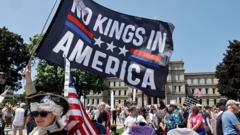Across the United States, citizens have mobilized in large numbers to protest President Donald Trump during a significant military parade held in Washington D.C. The protests, organized by the group "No Kings," were meant to counteract the pageantry of the military event, which coincided with Trump's birthday and aimed to celebrate the 250th anniversary of the U.S. Army.
Demonstrations erupted in cities like New York, Philadelphia, and Houston, where participants gathered holding placards critical of the Trump administration and waving American flags. This mobilization arises after several days of robust protests across Los Angeles concerning Trump's immigration policies, particularly his stringent deportation measures. Some speakers from various backgrounds, including lawmakers and union leaders, articulated their grievances, emphasizing the need to protect democratic principles and public health.
Despite Trump's warning of "heavy force" against any protests during the parade, the rallying cries brought together millions nationwide, with hundreds of protests reported. For instance, in Philadelphia, a nurse expressed a sentiment that spurred her participation, "I just feel like we need to defend our democracy," highlighting concerns over staffing cuts to public health services.
Los Angeles saw one of the largest congregations, amid heightened tensions and a strong law enforcement presence due to recent protests sparked by immigration raids. Protesters expressed outrage over family separations, with activist Jose Azetcla decrying the actions as "evil." Some protests turned confrontational, leading to instances where tear gas was deployed against demonstrators.
This emergence of protests marks the loudest collective dissent since Trump's re-election. However, public opinion appears divided, as surveys indicate that Trump's immigration policies maintain significant support, with many Americans viewing his initiatives as protective of public safety.
The moniker "No Kings" symbolizes the opposition to Trump's perceived overreach of presidential power in his second term. During the military parade, with soldiers and military equipment on display, Trump saluted the service members, affirming their dedication to fighting and winning for the nation.
Critics of the parade described it as a costly exercise in vanity, with estimated expenses ranging from $25 million to $45 million indicating a draw on public funds. Nevertheless, many supporters viewed the event as a necessary celebration of military sacrifices and service.
Experts have noted the striking contrast between the ongoing deployment of troops in Los Angeles to manage civil unrest while a military parade took place in the nation's capital. The presence of armed soldiers amidst a polarizing immigration debate has led to discussions on the implications of militarization in domestic policy.
Further complicating the protests was the cancellation of some "No Kings" events in Minnesota after a tragic shooting incident linked to a political figure. Local authorities hesitated to encourage turnout until safety could be ensured, but thousands still attended.
This unfolding narrative highlights the complexities of contemporary U.S. politics, with public sentiment around military displays and immigration policies playing crucial roles in shaping political mobilization across the country.





















